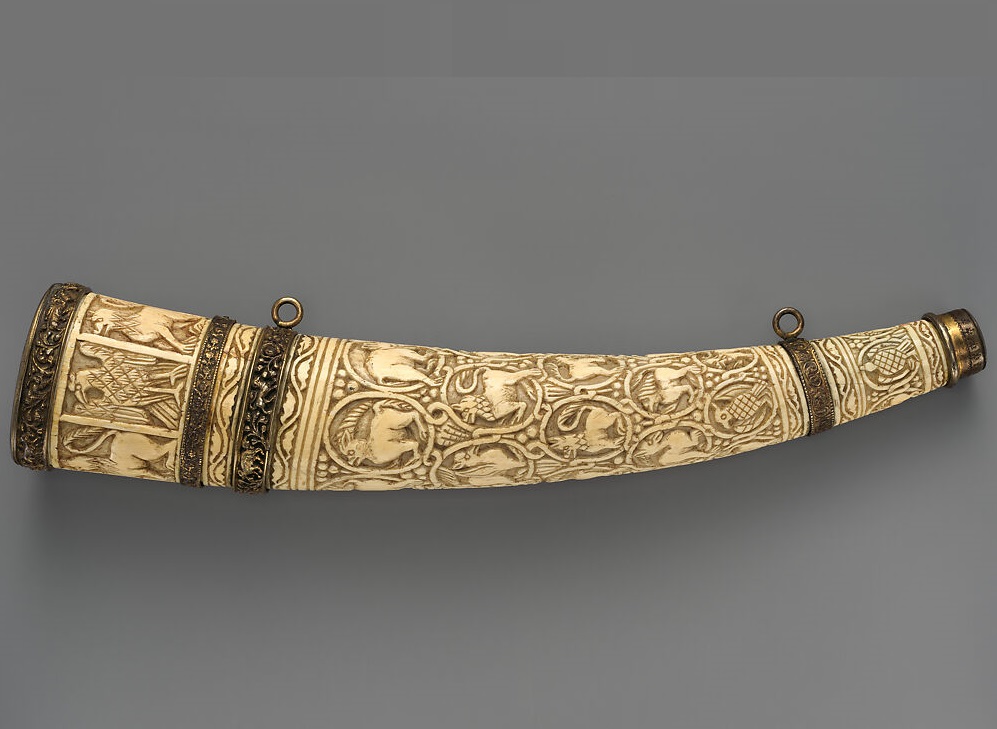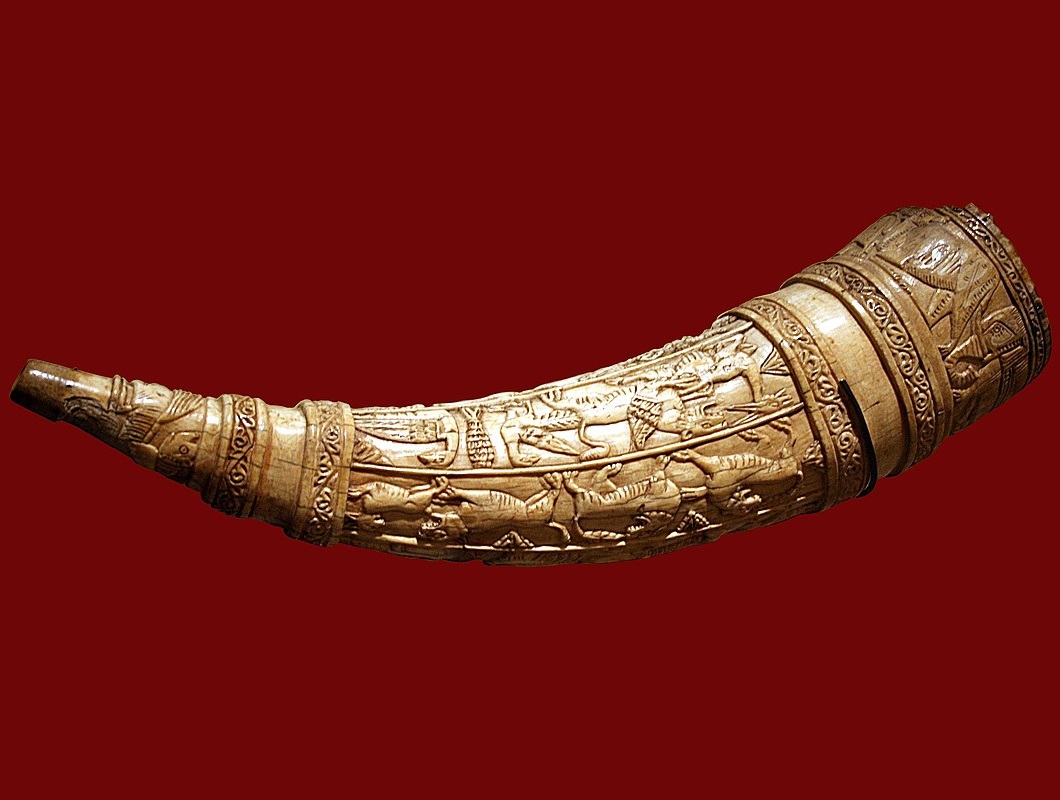Olifant
Woodwinds
Europe
Between 0 and 1000 AD
Video
The oliphant, also known as an olifant, is a wind instrument traditionally made from a carved and hollowed elephant tusk. It is an ancient type of horn that has been used primarily for signaling and ceremonial purposes. The instrument is associated with medieval and early Renaissance periods and is closely linked to the culture of Europe and parts of Africa. The oliphant is known for its curved, elongated shape and often features intricate carvings, engravings, or inlaid decorations. Though primarily a signaling instrument rather than a melodic one, its powerful and resonant sound was effective in communication over long distances.
The oliphant is classified as an aerophone, a category of wind instruments in which sound is produced by the vibration of air within a hollow chamber. More specifically, it is a type of natural horn, meaning it lacks valves or keys to change pitch. Instead, pitch variation is achieved through the player’s embouchure and breath control. Because of its historical function as a signaling instrument, it is considered part of the broader family of military and ceremonial horns rather than traditional musical instruments used in orchestral settings.
History
Origin and Development
The oliphant has its origins in the early medieval period, with its primary use recorded between the 9th and 15th centuries. The instrument was particularly significant in Europe, where it was employed by nobility, military leaders, and hunters. The term “oliphant” is derived from the Old French word “oliphant” or “olifant,” which itself traces back to the Latin “elephantus,” referencing the elephant tusks from which the instrument was crafted. The oliphant was predominantly used in Europe, especially in France, Germany, Italy, and England. However, similar horn instruments made from natural materials existed across Africa and Asia. African cultures, particularly those in the Sahel and West Africa, used tusk horns for ceremonial and signaling purposes, though their designs and functions differed from the European oliphants.
Prominent Centuries
The oliphant gained prominence in the 10th to 12th centuries, particularly during the medieval period. It was often associated with the Carolingian and Norman nobility, where it was used for military communication and hunting. By the Renaissance, its role diminished as more advanced brass instruments and battle signaling methods emerged. However, oliphants remained significant as ceremonial and decorative objects.
Materials Used
The primary material used to make an oliphant was elephant ivory. The tusk was hollowed out to form a resonant chamber, with one end serving as a mouthpiece and the other as an open bell to project sound. Many oliphants were elaborately decorated with carvings of animals, knights, hunting scenes, and religious motifs. Some were inlaid with precious metals, stones, or intricate engravings that depicted cultural and heraldic symbols. In some instances, replicas were made from wood, bone, or metal, but ivory remained the most prized and commonly used material.
Types of Oliphants
Oliphants can be classified based on their region, decoration, and intended function:
Hunting Oliphants – Used for signaling during hunts, often producing short, loud blasts to communicate between hunters.
Military Oliphants – Employed as a battlefield instrument to signal troop movements and alerts.
Ceremonial Oliphants – Highly decorated and used for noble or religious ceremonies, sometimes as status symbols rather than functional instruments.
African Tusk Horns – Though not identical to the European oliphant, similar tusk horns were used in African cultures for communication and ritualistic purposes.
Characteristics
Shape: Long, curved, and tapered.
Material: Primarily made of ivory, sometimes adorned with metal or jewels.
Decoration: Engraved with intricate patterns, religious symbols, or battle scenes.
Size: Varies, but typically ranges from one to three feet in length.
Sound: Deep, resonant, and powerful, designed for projection over distances.
Usage: Primarily for signaling rather than melody.
Sound Production and Playing Methods
The oliphant is a historical wind instrument made from an elephant tusk, primarily used in medieval Europe as a hunting or signaling horn. Its sound production relies on the player’s breath, similar to modern brass instruments. The musician blows air through a narrow mouthpiece or directly into the horn’s hollowed-out end, causing the air inside to vibrate and produce a rich, resonant tone. The oliphant typically produces a limited range of natural harmonics since it lacks valves or finger holes to alter pitch. The playing method of the oliphant is relatively simple yet requires control over breath pressure and embouchure. The player can create different pitches by adjusting their lip tension and airflow, much like a natural horn. However, due to its curved, tapering shape and dense ivory material, its sound is more powerful and penetrating, making it ideal for signaling over long distances. Historically, oliphants were associated with nobility and warriors, often richly decorated and used in battle or ceremonial events to communicate commands.
Roles in Music and Society
Hunting and Warfare
The oliphant played a crucial role in medieval hunting and military practices. During hunts, it was used to signal the location of game or alert fellow hunters. In battle, it served as a means of communication, signaling advances, retreats, or warnings.
Religious and Ceremonial Use
Many oliphants, especially those elaborately decorated, were used in religious and royal ceremonies. They sometimes functioned as gifts or symbols of power and were displayed in churches, castles, or noble households. The oliphant became a powerful emblem of knighthood and medieval chivalry. It is famously associated with the legend of Roland, a knight in Charlemagne’s army, who used an oliphant to call for help during the Battle of Roncevaux Pass. This association cemented its status as a symbol of loyalty, bravery, and heroism.
Cultural Significance
The oliphant, a carved ivory hunting horn, held significant cultural and symbolic value in medieval Europe, particularly between the 10th and 15th centuries. Originating from the tusks of African and Asian elephants, these instruments were intricately decorated with elaborate carvings, often featuring geometric patterns, hunting scenes, or religious motifs. The oliphant was primarily associated with nobility and chivalry, used by knights and aristocrats as a ceremonial or battle horn. One of its most famous appearances is in the medieval epic The Song of Roland, where the protagonist, Roland, uses his oliphant to call for aid in battle, cementing its association with heroism and loyalty.
Beyond warfare, oliphants were also status symbols, gifted between rulers as marks of diplomacy or used in religious contexts to signify divine authority. Their craftsmanship and material linked them to trade networks connecting Europe, Africa, and the Middle East, reflecting their role in both artistic and economic exchanges. Today, surviving oliphants are treasured museum artifacts, offering insights into medieval artistry, cross-cultural influences, and the symbolic power of music in history.
The oliphant is a fascinating instrument with deep historical roots. Though it was primarily used for signaling rather than music in the traditional sense, its presence in medieval and early Renaissance societies was profound. Crafted from elephant ivory and often intricately decorated, the oliphant was a symbol of status, power, and communication. Whether used in battle, hunting, religious ceremonies, or as an artistic relic, the oliphant remains an important cultural artifact. Today, it serves as a link to the medieval past, preserved in literature, art, and museum collections worldwide.
FAQ
How was the Olifant musical instrument constructed?
The Olifant was crafted from a single elephant tusk, intricately carved with detailed designs. The natural curvature of the tusk enhanced its resonant sound. It had a small mouthpiece opening, allowing for a powerful blast. These horns were often adorned with engravings depicting animals, warriors, or symbolic patterns.
What is the origin of the Olifant instrument?
The Olifant has its roots in medieval Europe, particularly among knights and royalty. It was inspired by hunting and war horns used in earlier civilizations. These instruments were brought to Europe through trade and conquests. They became iconic in French and Norman culture, often linked to heroic legends.
What compositions or literature mention the Olifant?
The Olifant is famously mentioned in "The Song of Roland," a medieval epic poem. In the story, Roland blows his Olifant to call for help in battle. The instrument is also referenced in historical chronicles and artwork. Its literary significance highlights its role in signaling and heroism.
 Links
Links
References
Other Instrument
Categories



















